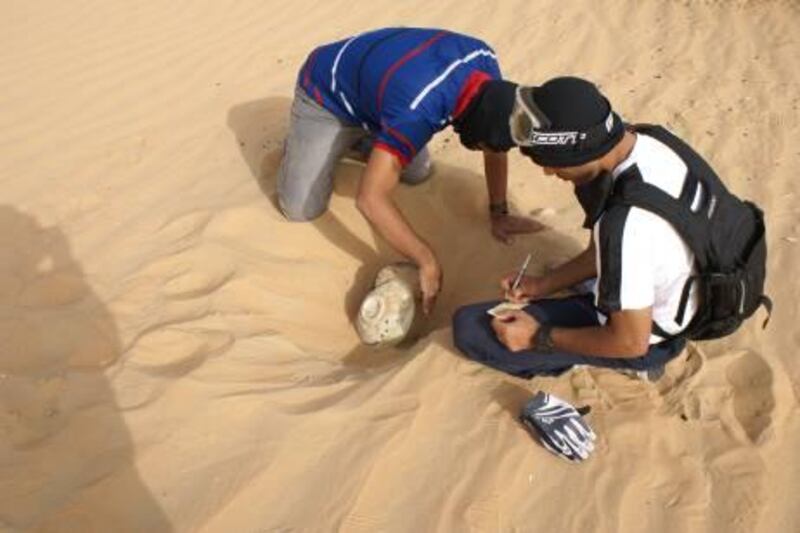AL AIN // Before the crack of dawn, while most of the country sleeps, seven young Emiratis are on their way to the heart of the desert searching for hidden treasure.
With survey and excavation tools, the team rides on dune buggies as they retrace the footsteps of their ancestors and the history of their land.
"We have the chance to unlock the mysteries of our past," said Ali al Meqbali, 26, an archaeologist who is a member of the team.
In many ways, the men are the Emirati version of Indiana Jones: all are archaeologists, with the exception of one geophysicist, and they sometimes find unexpected dangers while venturing into unknown, harsh terrain.
"One of us got lost in the desert once for a couple of hours and most of us had sand dune accidents," said Mr al Meqbali, who once suffered from a concussion after falling off a sand dune and tumbling down with his buggy.
"It is a lot of hard work. We regularly get sun-stroke and see mirages that affect our vision and driving," he said.
Mr al Meqbali joked that even though the men work all day in the harsh desert, none of them wear sunblock - because, as people of the desert, they simply don't need to use it.
The members of the team are all from Al Ain, in their mid-20s and working with the Abu Dhabi Authority for Culture and Heritage (Adach). Six of them were with the UAE Armed Forces before turning a new page and trying their hand at digging and documenting. The discipline they learnt under the Army turned out to be quite valuable in their current field of work.
"You need so much patience and repetition as an archaeologist until you can get some kind of answer to a question behind an artefact or site," said Omar al Kaabi, 26.
One of Mr al Kaabi's latest duties involved photographing and documenting pieces of pottery. In a span of eight months, he photographed and archived 40,000 pieces. Sometimes, he would take a photo of himself with a piece that he found particularly interesting.
"It may seem boring, but actually pottery really helps us with dating and telling the story behind the people that once used or made it," he said.
One of the latest comprehensive works done by the team of experts took almost three years, starting in 2008, and included archaeological surveying and mapping of more than 6,650 square kilometres of area between Al Khatim and Madinat Zayed in the Western Region of Abu Dhabi.
Seventy-two sites were marked and divided into two main periods. The first period was the late Stone Age, between 40,000 and 10,000 years ago, and the second was the late Islamic period, between the 18th and 19th century.
Some of the discoveries were remnants of ostrich eggshells that are modern when compared to the fossils of ostrich eggshells found in an earlier survey in a coastal area towards Mirfa. Those date back to the late Miocene Age six to eight million years ago.
But the discoveries that left an impression on the team included late Islamic-era sites where plates and cups, sometimes fully intact, were found buried in revisited campsites in the desert.
"The Bedouins were able to retrace and find their old camps with great skill and, slowly through our work in the desert, we have acquired some of that ability ourselves," said Hamdan al Rashedi.
"We can now differentiate between dunes and can estimate which dunes probably have a campsite under them."
Mr al Rashedi and Mohammed al Dhaheri both have an appreciation for the inherent skills gained from their line of work.
"None of us had any particular childhood attachments to artefacts or archaeology," said Mr al Dhaheri. "But now, as we are learning more and more, we feel privileged to have access and this connection with the past from all the periods."
Abdullah al Kaabi and Mr al Meqbali have a particular appreciation for the Stone Age.
"The tools created from that time are the foundation of the tools used today," he said.
"There is something mystical about that period," said Mr al Kaabi.
Each member of the team shares the work, with Waleed al Yafai as the sole geophysicist and the guiding light about where it is best to dig.
"If just a tiny piece of a wall is uncovered, we can use radars and magnetic field and density registered as a guide as to where the wall continues," he said.
The youngest member of the team, Abdulrahman al Nuaimi, 24, said his line of work gave him some answers about an archaeological site near his home that also happens to be one of Al Ain's most important sites: the Jebel Hafeet tombs.
"Right next door to me were tombs that are over 5,000 years old and have defined a whole period in history," said Mr al Nuaimi.
The dome-shaped tombs are from the Bronze Age, known as the Hafit Period or Hafit Cultural Horizon, dating from 3,200 to 2,700BC.
Mr al Nuaimi, like the rest of his team, initially enjoyed his country's heritage and the more recent history of the UAE.
But now, after digging for a couple of years, the men said they appreciate what may be found under the sand dunes that most people take for granted.






